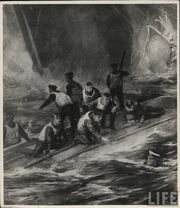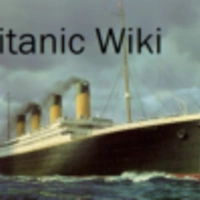As with many famous events, many alternative theories about the sinking of Titanic have appeared over the years. Theories that it was not an iceberg that sank the ship or that a curse caused the disaster have been popular reading in newspapers and books. Most of these theories have been debunked by Titanic experts, claiming that the evidence on which these theories were based was inaccurate or incomplete.
Myths and false legends surrounding the Titanic
- Jack Phillips reaching Collapsible lifeboat B, and dying of exposure
- Murdoch and Moody floating in sea, dead.
- The last music played by the ship's band being the hymn 'Songe d'Automne' or 'Autumn'
- Thomas Andrews was last seen in the smoking room-even though the steward who saw him there escaped in Lifeboat 5, the second boat to launch, and others claim to have seen him after that on the Boat Deck.
- The ship sinking in one piece, this was proved wrong when Robert Ballard discovered the wreck, broken in 2 pieces.
- The ship being given the number 3909 04 before her construction began. The number 3909 04 looks like 'NO POPE' in mirror writing, but that number had absolutely nothing to do with the Titanic.

The myth of Captain Smith at Collapsible B
- Captain Smith was claimed to be seen at Collapsible B, even trying to save an infant.
- The Aberdeen Press and Journal, a paper notorious for its parochial coverage, reported the sinking of Titanic with the headline "Aberdeenshire Man Drowned at Sea" (or something similar). This is an untrue Scottish urban legend.[1]
- There is a minor school of thought that it was not Titanic that sank but Olympic. Conspiracy theorists cited evidence in favour, including the Hawke incident, which seriously damaged Olympic. This supposedly motivated management to scuttle Olympic/Titanic and file an insurance claim. The two ships were dry-docked at the same yard at the same time (making a switch possible), and cosmetic changes were made, presumably to make the two ships more similar. A book: Beveridge, Bruce. Olympic & Titanic: The Truth Behind the Conspiracy.
- While the ship was being built in the Belfast shipyard, several Catholic workers reportedly walked off the job in protest when they noticed horrible blasphemies against Catholicism and the Virgin Mary spray-painted by Protestant workers on parts of the ship. One of the workers stated, "This ship will not finish its first voyage." The graffiti was supposedly noted by coal-fillers when the ship stopped at Queenstown, Ireland. In reality, Harland and Wolff employed very few Catholics at this time.
- The myth of the cursed Egyptian mummy. The mummy, Men-Kau Re, nicknamed Shipwrecker after changing hands several times and causing many terrible things to happen to each of its owners, exacts its final revenge by sinking the Titanic. There was no mummy on board.[2]
- The bottle of champagne used in christening Titanic did not break on the first try, which in sea lore is said to be bad luck for a ship. But Titanic was not christened at all, the White Star Line never christened their ships on launching. [3]
- The sinking of the Titanic was not the first time the internationally recognized Morse code distress signal "SOS" was used. The SOS signal was first proposed at the International Conference on Wireless Communication at Sea in Berlin in 1906. It was ratified by the international community in 1908 and had been in widespread use since then. The SOS signal was, however, rarely used by British wireless operators, who preferred the older CQD code. First Wireless Operator Jack Phillips began transmitting CQD until Second Wireless Operator Harold Bride suggested, half-jokingly, "Send SOS; it's the new call, and this may be your last chance to send it." Phillips, who perished in the disaster, then began to intersperse SOS with the traditional CQD call.
Alternative causes for the sinking
- A coal gas explosion (This started after a large hole was found in the starboard side of the wreck, caused by water compression)
- Titanic being sacrificed because, once construction had been completed, she was expected to be a potential perpetual financial loss. Supporters of this theory cite the claim that everyone concerned, the company and the officers aboard, had received iceberg warnings and yet the Titanic maintained a northern course instead of sailing to the south of the warning limit.
- In 2003 Captain L.M. Collins, a former member of the Ice Pilotage Service published The Sinking of the Titanic: The Mystery Solved proposing, based upon his own experience of ice navigation and witness statements given at the two post-disaster inquiries, that what the Titanic hit was not an iceberg but low-lying pack ice.
- Overspeed. The conclusion of theBritish Titanic Inquiry was “that the loss of the said ship was due to collision with an iceberg, brought about by the excessive speed at which the ship was being navigated”.[4] At the time of the collision it is thought that the Titanic was at her normal cruising speed of about 22 knots,[5] which was less than her top speed of around 24 knots. At the time it was common (but not universal) practice to maintain normal speed in areas where icebergs were expected.[6] It was thought that any iceberg large enough to damage the ship would be seen in sufficient time to be avoided. After the sinking, the British Board of Trade introduced regulations instructing vessels to moderate their speed if they were expecting to encounter icebergs. It is often alleged that Bruce Ismay instructed or encouraged Captain Smith to increase speed in order to make an early landfall, and it is a common feature in popular representations of the disaster. There is no evidence for this having happened, and it is disputed by many.[7]
- Californian ramming. It is believed by some that Captain Lord is a murderer, and rammed Titanic in a hit-and-run, thus the inaction of help that night.
Limited turning ability
The Titanic had triple-screw engine configuration, with reciprocating steam engines driving the wing propellers, and a steam turbine driving her center propeller. The reciprocating engines were reversible, while the turbine was not. When Murdoch gave the order to reverse engines to avoid the iceberg, he inadvertently handicapped the turning ability of the ship. Since the center turbine could not reverse during the "full speed astern" maneuver, it simply stopped turning. Furthermore, the center propeller was positioned forward of the ship's rudder, diminishing the turning effectiveness of the rudder.
Had Murdoch reversed the port engine, and reduced speed while maintaining the forward motion of the other two propellers (as recommended in the training procedures for this type of ship), experts theorize that the Titanic might have been able to navigate around the berg without a collision. However, given the closing distance between the ship and the berg at the time the bridge was notified, this might not have been possible.
Additionally, Titanic experts have hypothesized that if Titanic had not altered its course at all and had run head-on into the iceberg, the damage would only have affected the first or, at most, the first two compartments. The liner SS Arizona had such a head-on collision with an iceberg in 1879, and although badly damaged, managed to make St John's, Newfoundland for repairs. Some dispute that Titanic would have survived such a collision, however, since Titanic's speed was higher than the Arizona's and her hull much larger, and the violence of the collision could have compromised her structural integrity.
Construction faults
Though the topic is seldom discussed, there is some speculation as to whether Titanic was constructed by methods considered sufficiently robust by the standards of the day. In the documentary series Seconds from Disaster, this was investigated further. Rumored faults in the construction included problems with the safety doors and missing or detached bolts in the ship's hull plating. This may have been a major contributing factor to the sinking and that the iceberg, in part with the missing bolts and screws, eventually led to the demise of Titanic.
However, Titanic's hull was held together by rivets, which are intended to be a permanent way of attaching metal items together, whereas bolts can be removed and would require periodic tightening unless the nut and bolt are welded after being screwed together. Welding technology in 1912 was in its infancy, so this was not done. While issues with Titanic's rivets have been identified from samples salvaged from the wreck site, many ships of the era would have been constructed with similar methods and did not sink after becoming involved in collisions. There was a claim that the rivets of the Titanic had not been properly tempered, leaving them brittle and sensitive to fracture in the infamous collision. [8]
Although sealing off the Watertight Bulkheads with watertight decks would have increased the survivability of a vessel such as Titanic, it would have by no means ensured the survival of a ship with as much underwater damage as Titanic sustained in her collision with the iceberg; it was a big iceberg. Even if the compartments themselves had remained completely watertight, the weight of the water would still have pulled the bow of the ship down to the point where decks above the watertight deck would have been below the waterline. The ship would then have flooded via the portholes and sunk anyway. It should also be noted that watertight decks would have hampered access to the lower sections of the ship and would have required watertight hatches, all of which would have had to be properly sealed to maintain the barrier between the incoming water and the rest of the ship. As the increased survivability that such watertight decks would have offered is questionable, they are generally considered to this day to be impractical in merchant vessels (though some military vessels, which are exposed to much greater risk of flooding by virtue of being targets for enemy mines and torpedoes, do feature such decks).
RMS Olympic, built to almost identical specifications by the same builders as Titanic, was involved in several collisions during the course of her operational lifetime, one of which occurred before Titanic sank; and Olympic's hull was modified to protect her from flooding in a fashion similar to her ill-fated sister's. None of these collisions threatened to sink the ship, suggesting that the Olympic-class liners were built to be sufficiently tough and did not suffer from slipshod construction.
It has also been learned that when the ship was built, the front suspension joint was very strong. But the aft suspension joint was not, and the aft suspension joint was where the ship broke in two. This means that if the aft suspension joint had not been as weak, then the ship may not have broken in two.
| General Titanic Pages |
|---|
| RMS Titanic
Numbers · Books and weblinks · Sinking · Passenger and crew list · Timeline · Changes in safety practices · Myths, legends and alternative theories · Lifeboats · British Inquiry · US Inquiry · Wreck · Maritime Memorial Act |
Notes
- ↑ [1]
- ↑ [2]
- ↑ [3]
- ↑ Final Report of the British Board of Trade Inquiry
- ↑ British Inquiry - Testimony of JG Boxhall -Fourth Officer - ss "Titanic", Q15645
- ↑ British Inquiry – Testimony of G Affeld, Marine Superintendent Red Star Line Q22583 & Q25615/16
- ↑ Paul Louden-Brown "The White Star Line; An Illustrated History 1869-1934"
- ↑ Seconds from Disaster, Sinking of the Titanic, documentary, aired on National Geographic Channel
